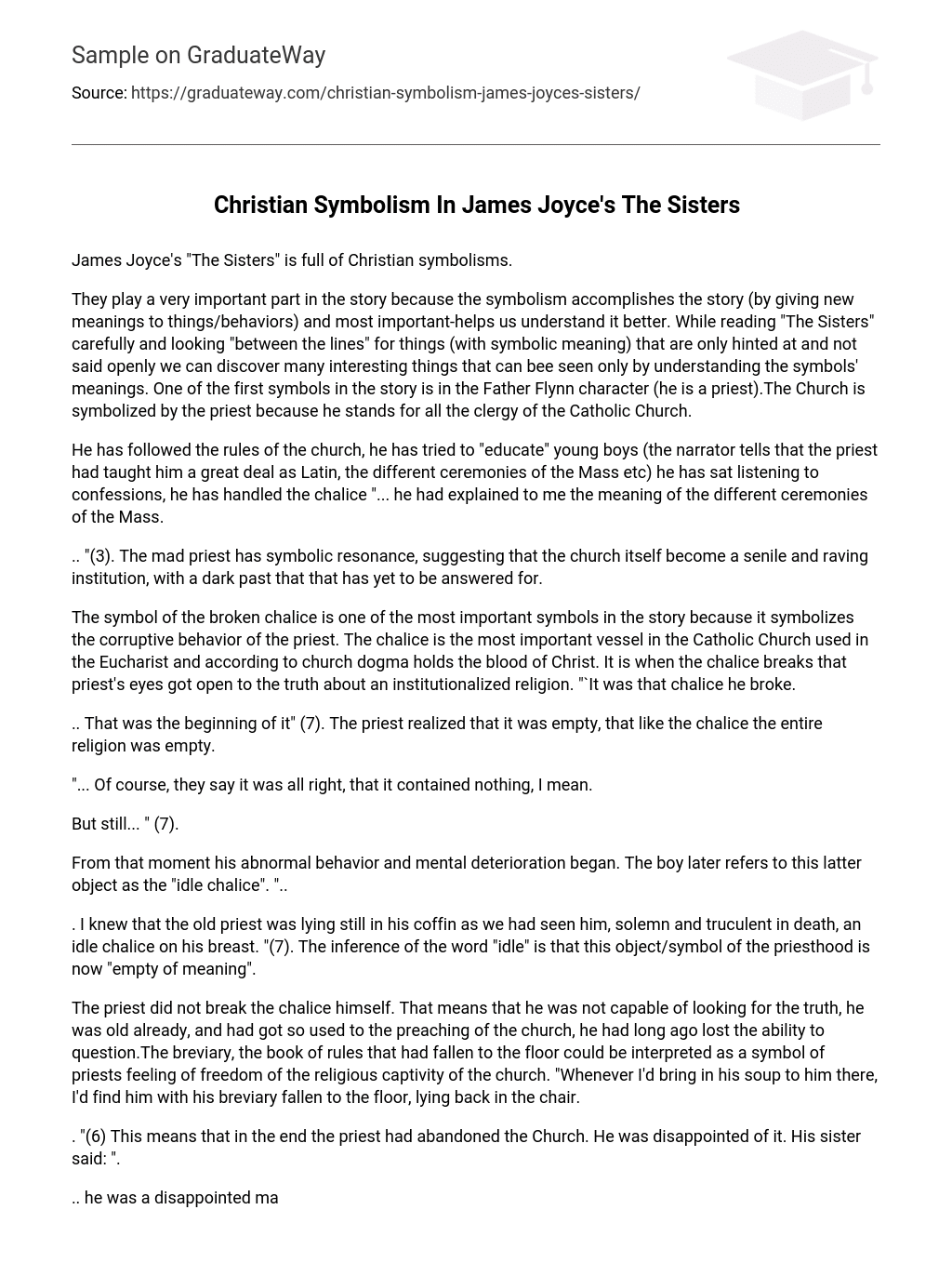James Joyce’s “The Sisters” is full of Christian symbolisms.
They play a very important part in the story because the symbolism accomplishes the story (by giving new meanings to things/behaviors) and most important-helps us understand it better. While reading “The Sisters” carefully and looking “between the lines” for things (with symbolic meaning) that are only hinted at and not said openly we can discover many interesting things that can bee seen only by understanding the symbols’ meanings. One of the first symbols in the story is in the Father Flynn character (he is a priest).The Church is symbolized by the priest because he stands for all the clergy of the Catholic Church.
He has followed the rules of the church, he has tried to “educate” young boys (the narrator tells that the priest had taught him a great deal as Latin, the different ceremonies of the Mass etc) he has sat listening to confessions, he has handled the chalice “… he had explained to me the meaning of the different ceremonies of the Mass.
.. “(3). The mad priest has symbolic resonance, suggesting that the church itself become a senile and raving institution, with a dark past that that has yet to be answered for.
The symbol of the broken chalice is one of the most important symbols in the story because it symbolizes the corruptive behavior of the priest. The chalice is the most important vessel in the Catholic Church used in the Eucharist and according to church dogma holds the blood of Christ. It is when the chalice breaks that priest’s eyes got open to the truth about an institutionalized religion. “`It was that chalice he broke.
.. That was the beginning of it” (7). The priest realized that it was empty, that like the chalice the entire religion was empty.
“… Of course, they say it was all right, that it contained nothing, I mean.
But still… ” (7).
From that moment his abnormal behavior and mental deterioration began. The boy later refers to this latter object as the “idle chalice”. “..
. I knew that the old priest was lying still in his coffin as we had seen him, solemn and truculent in death, an idle chalice on his breast. “(7). The inference of the word “idle” is that this object/symbol of the priesthood is now “empty of meaning”.
The priest did not break the chalice himself. That means that he was not capable of looking for the truth, he was old already, and had got so used to the preaching of the church, he had long ago lost the ability to question.The breviary, the book of rules that had fallen to the floor could be interpreted as a symbol of priests feeling of freedom of the religious captivity of the church. “Whenever I’d bring in his soup to him there, I’d find him with his breviary fallen to the floor, lying back in the chair.
. “(6) This means that in the end the priest had abandoned the Church. He was disappointed of it. His sister said: “.
.. he was a disappointed man”(6). The objects that the boy saw in his dream: long velvet curtains and a swinging lamp of antique fashion have symbolic meanings and they hint at sexuality.
The boy tries to recollect the last part of the dream and remembers “… I had noticed long velvet curtains and swinging lamp of antique fashion” (4).
The velvet curtains symbolize sensuality and the swinging lamp is an erotic symbol. Other symbols that give us hints which reinforce the argument of the sexual implications in the priest’s case are Joyce’s description of Father Flynn’s mouth (tongue that lies on the lower lip, his smile). “When he smiled he used to uncover his big discolored teeth and let his tongue lie upon his lower lip-a habit which had made me feel uneasy..
. “(4).The “smile” and the “moist with spittle” lips are provoking troubling questions because smiling and “spittle on the lips” are akin to sexuality. It makes the reader suspect that maybe there was something sexual between the boy and the priest.
James Joyce has done quite a job of peaking our interest in what follows, hinting at themes he considers important by using symbols. The use of symbols is one of the reasons that make Joyce’s works so accomplished. Those symbols make us read the story carefully and understand its deep meaning. They intrigue us and keep us guessing after reading what exactly the writer has meant in his story.





